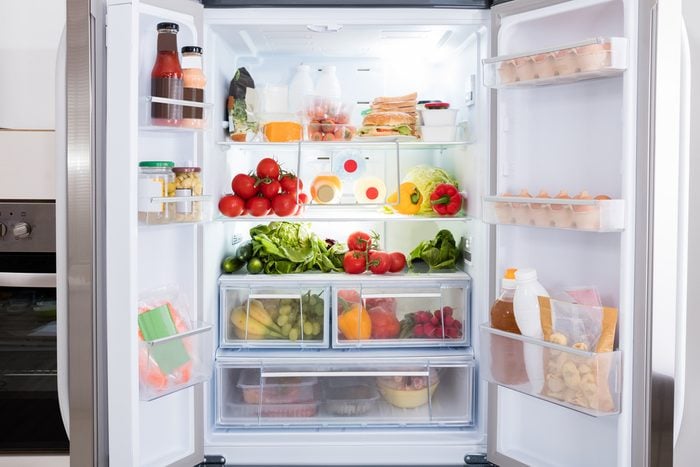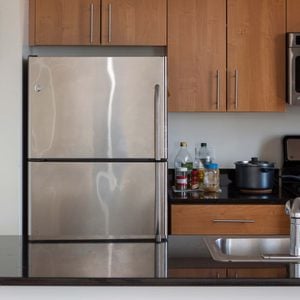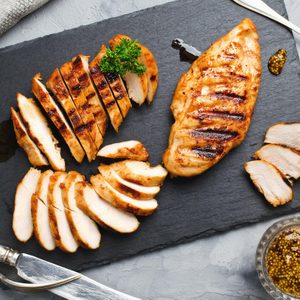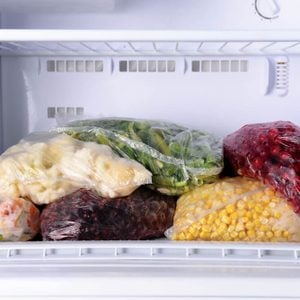This Is the Temperature Your Refrigerator Should Be
Updated: Nov. 22, 2022

Keep your food fresh longer—and help prevent foodborne illness—by keeping your refrigerator humming at the right temperature
Is your food going bad more quickly than usual? Does your milk feel a little warm? If you know how long fresh produce should last and how long food is good in the fridge, but still find your food going off extra fast, your fridge settings could be too warm. Even the best refrigerator with the greatest fridge organization can cause food waste if the temperature settings are wrong. When produce is wilted and cheese is sweating, your fridge temp needs a checkup. If your problem isn’t how to store food but knowing what temperature a freezer or fridge should be, read on.
What temperature should a refrigerator be?
The ideal refrigerator temperature is at or below 40°F (4°C), and your freezer temperature should be 0°F (-18°C). While some refrigerators and freezers are outfitted with all the bells and whistles, they might not have a built-in thermometer. Fortunately, appliance thermometers are generally inexpensive and can be found in most kitchen appliance stores or on Amazon.
Why is it important to keep your refrigerator at the right temperature?
Finding the optimal refrigerator temperature is key to making sure your produce and leftovers last as long as possible, and it’s one of the easiest ways to prevent foodborne illnesses that can result from eating expired eggs or sour milk. While properly freezing is a great way to store bulk items like meat, the FDA notes that it does affect “tenderness, flavor, aroma, juiciness and color” the longer your foods are frozen. Here’s our guide to navigating foods with freezer burn.
If you’re worried about your leftovers going bad before you can get to them (how long do leftovers last in the fridge anyway?), get creative! As Taste of Home food editor Peggy Woodward says, “Leftover meat can be added to a simple soup or combined with eggs into a flaky quiche or frittata. If you have a small amount of leftover cooked vegetables, put an egg on top and enjoy the dish for supper. Leftover grains make tasty fried rice. Fruits can go into a fruit salad, chopped vegetables into a stir-fry.”
Why is my fridge icing up?
It’s frustrating when you open your refrigerator and find frozen food. Especially when something freezes that can’t be salvaged, like lettuce or other fresh produce. Is the fridge broken? What’s going on? Luckily, a freezing issue can usually be fixed with a simple solution. Here are a few possible reasons your fridge is getting too cold.
Temperature setting
Check the temperature setting on your refrigerator. It should be set between 37°F and 40°F—the ideal refrigerator temperature to keep food fresh and cold but not frozen. If you have a numbered dial setting instead of a temperature reading, the highest number is usually the coldest (generally 5). However, this can change from brand to brand, so be sure to check your appliance user manual. Most appliance brands recommend keeping the fridge on the coldest setting, but if your food is freezing, try turning it down to 4.
Food placement
Refrigerators need sufficient air circulation to maintain a proper temperature. Make sure your fridge isn’t overloaded and food isn’t blocking any of the air vents. On the other hand, an understocked fridge can be a problem as well. Without enough items inside the fridge, the cold air settles at the bottom of the fridge and might freeze the food in your bottom drawers.
Leak in the door seal
If your fridge is leaking cold air due to a faulty door seal, the fridge will constantly be running trying to keep the temperature at the right level. And if your fridge is working in overdrive, it could cause freezing (or worse yet, the motor to go out!). Inspect the door seal and look for tears or warping, then replace if needed.
The best refrigerator rules to follow
These are the best practices to keep your fridge in tip-top shape and ensure your food stays fresh.
- Learn how to clean a refrigerator to prevent bacteria buildup or weird spills and smells.
- Buy a fridge thermometer. This way you can always monitor the temperature and make any adjustments, if necessary.
- Close the door! It’s easy to leave the door open while you’re cooking or unpacking groceries, but only leave the door open when absolutely necessary.
- Spread out your food. It may seem silly, but keep your food spread out so air can properly flow through the fridge and freezer. A fully stocked fridge is more likely to be warmer than a less stocked one.
- Clean your coils. Like other appliances, your fridge might need a little TLC from time to time. Make sure to clean the coils at least once per year to avoid refrigerator repairs.
- Minimize the amount of moisture in the fridge by using humidity-controlled fruit and vegetable storage drawers and storing food in airtight reusable storage containers.
- Let food cool before putting it in the fridge, or else it will heat up the space around it and allow possible bacterial growth.
What is the life expectancy of a refrigerator?
The average life expectancy of the best refrigerator brands is between 10 and 15 years, though some may last a shorter or longer time than that. There are signs that your appliance is reaching the end of its useful life and that it’s time to start thinking about a replacement. When you notice these, it’s important to pay attention and start looking for a new one right away—you don’t want your fridge to suddenly die with no replacement! This is how long food can last in a fridge without power. (Hint: It’s not very long!)
You should start looking for a new fridge when:
- It doesn’t keep temperature, and food is going bad quickly.
- There is condensation on the outside of the fridge. This shows that it’s not effectively keeping the cold air inside.
- The fridge is too loud—or too quiet. This indicates the motor is either working overtime or barely working at all, which are both bad signs.
- The coils are too hot. This means the fridge is using too much power to try to keep things cool inside.
- There are cracks in the shell or the rubber gasket of the door. These break the seal that keeps the cold air in, creating a leaky and too warm fridge.


